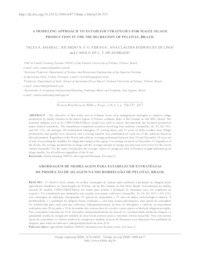A modeling approach to establish strategies for maize silage production in the micro-region of Pelotas, Brazil.
A modeling approach to establish strategies for maize silage production in the micro-region of Pelotas, Brazil.
Author(s): AMARAL, T. A.; BRAGA, R. N. F. G. P.; LIMA, A. C. R. de; ANDRADE, C. de L. T. de
Summary: The objective of this study was to evaluate some crop management strategies to improve silage production by family farmers in the micro-region of Pelotas, southern State of Rio Grande do Sul (RS), Brazil. The seasonal analysis tool of de CSM-CERES-Maize model was used to assess aboveground dry biomass production under rainfed conditions. The simulations comprised scenarios involving four cultivars (Amarelão, AL 30, AG 5011 and AG 122), six nitrogen (N) fertilization strategies, 52 sowing dates, and 21 years of daily weather data. Silage productivity and quality were assessed, and a sowing window was established for each one of the cultivars based on this information. Regardless of the N rate and cultivar, sowings performed between June 26 and December 19 were not at risk of exceeding the deadline for silage harvesting in the region. For sowing occurred on December 19, regardless of the N rate, the average productivity of silage and the average amount of energy per unit area were lower for the creole variety Amarelão. For the same sowing date the average values of energy per unit of biomass weight indicated good silage quality, for all cultivars regardless of the N rate.
Publication year: 2017
Types of publication: Journal article
Unit: Embrapa Maize & Sorghum
Keywords: Agricultura familiar, DSSAT, Fitomassa seca, Parte aérea
Observation
Some of Embrapa's publications are published as ePub files. To read them, use or download one of the following free software options to your computer or mobile device. Android: Google Play Books; IOS: iBooks; Windows and Linux: Calibre.
Access other publications
Access the Agricultural Research Database (BDPA) to consult Embrapa's full library collection and records.
Visit Embrapa Bookstore to purchase books and other publications sold by Embrapa.

